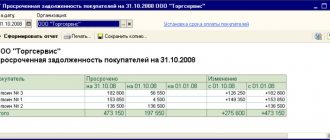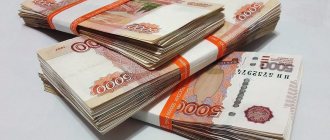When can you start taking inventory?
Of course, it is physically impossible to conduct a complete inventory of all property and liabilities of an organization in one day.
Therefore, in accordance with the provisions of Art. 12 of the Federal Law of November 21, 1996 N 129-FZ “On Accounting” and clause 1.5 of the Methodological Guidelines for Inventory of Property and Financial Liabilities (approved by Order of the Ministry of Finance of Russia of June 13, 1995 N 49, hereinafter referred to as the Guidelines for Inventory) of organizations, including budgetary institutions, can begin to conduct mandatory annual inventories as early as October 1, 2008. The results of these inventories are considered sufficient to confirm the actual availability of property and the state of payments when preparing annual reports for 2008.
It is advisable for the head and chief accountant of the organization to draw up an inventory schedule that will allow, throughout the entire fourth quarter of 2008, to systematically, without fuss and unnecessary stress, carry out all the necessary procedures and “fully armed” approach the preparation of the annual report for 2008.
Follow the instructions strictly
Higher authorities also provide additional instructions on the procedure for conducting an inventory and recording its results.
In particular, in the considered Order of the Department of Health of the Moscow Government dated 05.08.2008 N 592 the following instructions are given.
Firstly, when conducting an inventory, it should be considered mandatory to compare actual availability with accounting data, and in this regard, strictly check the correctness and completeness of the organization of primary accounting and the condition of technical documentation.
Secondly, special attention must be paid to identifying unaccounted for and not previously capitalized fixed assets and other valuables.
Thirdly, it is necessary to identify unused equipment and materials and, in the explanatory note to the annual report, indicate the reasons for the presence of unused equipment and the timing of its implementation.
Fourthly, when taking inventory of precious metals, diamonds and products made from them, be guided by Order of the Ministry of Finance of Russia dated August 29, 2001 N 68n “On approval of the Instructions on the procedure for recording and storing precious metals and precious stones, products made from them and maintaining records during their production and use and treatment."
Fifthly, working inventory commissions must be created to carry out the inventory. First of all, it is necessary to approve the central working inventory commission and the inventory calendar plan, after which centralized accounting workers should be distributed among institutions to participate in the inventory commissions.
Regulatory regulation
The procedure for conducting an inventory in organizations is defined in the Guidelines for the inventory of property and financial obligations, approved by order of the Ministry of Finance of the Russian Federation dated June 13, 1995 No. 49.
The guidelines include the following sections:
- General provisions
- General rules for conducting inventory.
- Rules for conducting an inventory of certain types of property and financial obligations:
- Preparation of inventory comparison sheets.
- The procedure for regulating inventory differences and recording inventory results.
To carry out inventory in organizations, a permanent inventory commission is created. When there is a large volume of work, working inventory commissions are created to simultaneously carry out inventory.
Based on the reasons for conducting the inventory, the following are classified:
Planned inventories are carried out according to schedule within the specified time frame.
Unscheduled inventories are carried out: when transferring cases to materially responsible persons; after natural disasters; theft and other prevailing circumstances in the organization.
inventory schedule plan | Legal Help
Responsible: Chairman of the Inventory Commission Chief Accountant Deadline -
- Approve the inventory results by the General Director.
Responsible: Chairman of the Inventory Commission Deadline
- Conduct a final meeting on the results of the inventory.
Responsible: Chairman of the Inventory Commission Completion date Inventory plan prepared by: Chairman of the Inventory Commission " " " " 201 If you have questions, write, we will help you for free, we will tell you, we will send you the necessary regulatory documents.
The inventory regulation is part of the organization’s accounting policy. It is advisable to develop it before January 1 of the year for which the organization will report.
The manager sets the deadlines for carrying out planned inventories. The inventory schedule is formed in the context of the property and liabilities under study.
The purpose of sudden inventories is to take the financially responsible person by surprise.
Unscheduled inspections are carried out according to the inventory plan kept by the manager or chief accountant.
Subscribe to our channel in Yandex.
Enter the site
Inventory plan. Watch the video for 5 minutes and you will get a clear picture of the topic. Then you will read all the information in more detail and download what you need for free. inventory plan.
View more presentations or Upload your own. Sample “I approve” General Director of Forum LLC I.I. Ivanov
" " " " 201_ g
Plan for conducting inventory of finished goods warehouse.
In accordance with Order No. 164 of September 20, 2020 “On conducting an inventory of the finished product warehouse,” carry out the following activities:
- Determine the material assets of the finished product warehouse that have lost their marketable appearance, and write them off in the prescribed manner.
Inventory report
- Leasing, subleasing, financial lease agreement
- License, sublicense agreement
- Contract of exchange, barter, exchange
- Lease agreement, sublease of residential premises
- Contract for performance of work, provision of services
- Contract of training, internship, retraining
- Debt transfer agreement
- Contract, subcontract
- Contract of agency, contract of guarantee
- Contract for the supply of goods, products, equipment
- Representation agreement: legal, commercial
- Agreement on joint activities
- Insurance and reinsurance agreement
- Agreement on assignment of claims, assignment agreement
- Agreement on storage of goods, property
- Employment contract, contract, agreement
- Certification inscription
- Other agreements
Quote for the ages It is very difficult to sincerely serve God.
Any organization conducts an inventory of material assets at least once a year.
To do this, it is necessary to appoint a special commission from among authorized employees and issue an order to conduct an inventory.
Let's look at how to do this correctly. The procedure and schedule for conducting an inventory in an organization must be enshrined in the accounting policy for accounting purposes (clause.
4 PBU 1/2008). However, an inventory commission is created for each specific case; its composition, powers, as well as the timing of the inventory must be enshrined in a separate internal act of the organization.
Therefore, let’s look at a sample of filling out an inventory order for 2020 in more detail and learn how to draw up this document correctly.
When an inventory is needed A sample order for an inventory is usually required in some cases listed in paragraph.
Quarterly report of the open joint-stock company "Mosoblstroymaterialy"
24).
Table 24
| Name of inventory objects | Inventory deadlines |
| 1. Fixed assets (at least once every two to three years) | On January 1 of a particular year |
| 2. Library collections (at least once every five years) | On January 1 of a particular year |
| 3. Intangible assets (at least once a year before drawing up the annual report, but not earlier than December 1 of the reporting year) | As of January 1 of the reporting year |
| 4. Inventory assets (at least once a year, before drawing up the annual report, but not earlier than October 1 of the reporting year) | As of November 1 of the reporting year |
| 5. Work in progress and expenses for future years (at least once a year) | As of January 1 of the reporting year |
| 6. Animals and young animals (at least once a year) | As of January 1 of the reporting year |
| 7. Cash, monetary documents and forms of strict reporting documents (at least once a month) | On the 1st day of each month of the reporting year |
| 8. Settlements with banks (for current accounts, foreign currency accounts, deposit accounts, loan accounts, etc.) Upon receipt of bank statements and confirmation of balances as of January 1 of the reporting year. | As of January 1 of the reporting year |
| 9. Calculations for payments to the budget and social funds (at least once a quarter) | On April 1, July, October, January |
| 10. Settlements with buyers, contractors and customers; settlements with other debtors and creditors (at least once a quarter) | On April 1, July, October, January |
| 11. Reserves, upcoming expenses and payments (at least once a year) | As of January 1 of the reporting year |
Specific audit issues are determined by the program (list) of the main audit issues. The audit program includes its topic, the period that the audit should cover, a list of the main objects and issues subject to audit, and is approved by the head of the control and audit body.
The preparation of an audit program and its implementation must be preceded by a preparatory period, during which the audit participants are required to study the necessary legislative and other regulatory legal acts, reporting and statistical data, and other available materials characterizing the financial and economic activities of the organization being audited. The audit program contains the following sections:
• purpose of the audit;
• issues to be verified;
• means and conditions necessary for conducting the audit;
• terms and place of execution;
• composition of audit participants;
• forms of documenting the audit.
The program is developed on the basis of current instructional material and experience accumulated by the auditing body. The program is approved by the head of the auditing body or the customer.
In the section “Purpose of the audit” the main objectives of the audit are formulated, for example: Analysis of the financial condition of the joint-stock company. The influence of receivables and payables on the financial and economic activities of the enterprise and settlements with the budget. Checking the legality and efficiency of the use of non-current assets. The objects of audit are listed, for example, a joint-stock company, its subsidiaries and branches. Often this section provides a list of structural divisions of the organization.
The section “Issues to be verified” lists the areas of the organization’s financial and economic activities; for example, the program may list non-current assets: fixed assets, capital investments, securities, investments in authorized capital, equipment for installation.
An audit of the financial and economic activities of an organization is carried out by:
• checking constituent, registration, planning, reporting, accounting and other documents in form and content in order to establish the legality and correctness of the transactions performed;
• checking the actual compliance of completed transactions with the data of primary documents, including the facts of receipt and issuance of funds and material assets indicated in them, actual work performed (services rendered), etc.;
• organizing procedures for actual control over the availability and movement of material assets and cash, the correctness of cost formation, the completeness of the receipt of products, the reliability of the volumes of work performed and services provided, ensuring the safety of funds and material assets by organizing inventories, surveys, control runs of raw materials and materials into production, control analyzes of raw materials, materials and finished products, control measurements of completed volumes of work, examinations, etc.;
• checking the accuracy of the reflection of transactions performed in accounting and reporting, including compliance with the established accounting procedures, comparison of entries in accounting registers with data from primary documents, comparison of reporting indicators with accounting data, arithmetic verification of primary documents;
• checking the use and safety of budget funds, funds of state extra-budgetary funds and other state funds, income from state-owned property;
• checking, if necessary, the organization and state of internal (departmental) control.
The section “Facility and conditions necessary for conducting an audit” contains a list of office equipment, communications, delivery, living conditions, working hours, etc.
The head of the audited organization is obliged to create appropriate conditions for the audit team members (controller-auditor) to conduct an audit - provide the necessary premises, office equipment, communication services, office supplies, provide typing work, etc.
If employees of the audited organization refuse to provide the necessary documents or other obstacles arise that do not allow the audit, the head of the audit team (controller-auditor), and, if necessary, the head of the control and audit body, reports these facts to the body on whose behalf the audit is being carried out.
The section “Dates and Place of Execution” indicates the start and end times of the audit, intermediate target dates, and the location of the audit objects.
The section “Composition of audit participants” provides a list of persons admitted to the audit. A list of persons with access to confidential information can be compiled separately.
A comprehensive audit involves the participation of specialists in production technology, planning, supply, sales, finance, accounting, etc. The head of the audit ensures the correct balance of forces on site, monitors the completeness and quality of the inspection of individual sections of the facility, provides practical assistance to the audit participants in their work, manages the preparation of audit materials, and represents them in the relevant services and organizations.
The composition of the audit participants is formalized by a resolution of the state body or an organization order, which also sets the audit period.
Participants of the audit team (controller-auditor), based on the audit program, determine the need and possibility of using certain audit actions, techniques and methods for obtaining information, analytical procedures, the volume of data samples from the audited population, providing a reliable opportunity to collect the required information and evidence.
The preparation of auditors for the audit ends with an instructional meeting held by the head of the audit.
Documentation of inventory
Managers and decision makers may wonder how to take inventory and document it. The value of the check and its legal force will depend on the correctness of the actions.
To carry out the audit, standard documents have been developed that need to be used at a certain stage of the inventory. Even at the very beginning, the manager must draw up and put into effect an order to conduct the appropriate inspection (documentation of the inventory begins with this).
This paper is the primary accounting document. For ease of inspection, a single form INV-22 was developed. It displays the timing of the inventory, the inventory object, and the list of responsible persons. The order contains information about all employees included in the inventory commission. The reason for the inventory is also indicated in the order.
The order must contain information about the event that caused the inventory. There may be several options here. For example, a financially responsible person quits and a new employee is hired in his place. In this case, it is necessary to take an inventory and only then transfer the property to the new employee. There are other examples of reasons for inventory in the order: revaluation of property, unscheduled inspection and others.
The order is a signal for financially responsible persons to prepare inventory items. Those materials, valuables and other objects of inspection that are under the control of the employee must be prepared by him. Preparation means sorting, conveniently positioning valuables to make inventory processing easier.
When preparing, the MOL must follow the order. All accountable objects are checked not in groups, but individually.
Inventory acts
During the inspection, responsible persons receive specific data, which must be entered into specialized acts. They display information not only about existing values. Inventory documents also contain information about those objects that should arrive at the enterprise in the near future.
For example, an organization has entered into a contract with another company for the supply of equipment. Payment for them has already been made, but the equipment itself has not arrived. Information about it must still be included in inventory documents.
If during the inspection inconsistencies were discovered between actual and accounting indicators, then it is necessary to draw up a report for each case.
There are several unified forms of reports that allow you to display all the data obtained during the audit. Based on them, conclusions are drawn regarding the existing surpluses and shortages. The following documents are used to carry out inventory:
- INV-3 (shows the value of actual indicators, does not include data on objects that are not in the enterprise’s warehouse);
- INV-4 (this is an addition to the previous form, it displays the total cost of assets available);
- INV-5 (contains information about objects taken by the organization for temporary storage);
- INV-6 (these documents, prepared during inventory, display information about those valuables that were not yet in the warehouse during the inspection, but were on the way).
Other forms of acts are also used. Based on the matching statements, acts INV-18 and INV-19 are filled out. They contain information about existing surpluses and shortages (including cost and quantitative indicators). You can read more about the INV-18 and INV-19 forms, and also see samples in the article.
When taking inventory, different forms of documents are used. But their goal is the same - to produce generalized indicators.
Any of the acts is drawn up in 2 copies at once - one is sent to the accounting department, and the other is given to the employee who is the MOL.
At the end of the inspection, all results obtained are given to the head of the organization. Depending on the results, he can punish or reward financially responsible persons. But now the manager will not have a question about what documents are needed to carry out an inventory.
Based on the results of the audit, the operating strategy of individual departments or the enterprise as a whole may be changed. For example, if the organization has too many reserves, the technology for their purchase may be changed or production volumes may be increased.
When entering information into acts and matching sheets, the responsible person may have a question about how to properly document the inventory. You need to remember the following rules:
- primary documents can be filled out not only on a computer, but also manually;
- when making corrections, it is necessary to make a footnote, which must be signed by all members of the commission and the MOL;
- There should be no empty cells in the documents; if some information is missing, then a dash is placed in its place (this helps prevent subsequent changes);
- all designations must be identical to those used in accounting;
- if the act consists of several pages, then they must be stapled, which will eliminate the possibility of loss or confusion of data.
All employees involved in the inventory must sign the primary documents. Otherwise they will be invalid.
Inventory procedure
At this meeting, the head of the audit has the opportunity to focus the audit participants on the main tasks that need to be solved, give the auditors a number of practical tips on organizing work at the audit site, their personal behavior during the audit, listen to each audit participant and explain any issues to him.
At the meeting, the readiness of the auditors for the audit is checked. If it turns out that the audit participants do not know the necessary regulatory materials well, or have not studied the information characterizing the activities of the object scheduled for audit in sufficient depth, the audit must be postponed. It is better to start it later, and prepare more thoroughly before that.
The section “Forms for documenting the audit” provides samples of inventories, acts, statements, and the form of the final audit report.
A complete, correctly drawn up audit program concentrates the attention of the auditor on the main issues of the audit, reveals their content, i.e. helps the auditor check each question in detail. An insufficiently thought-out program can lead to a haphazard verification of documents, the results of which often boil down to the accidental discovery of violations in the organization’s activities; if a lot of time is spent, the audit may not give the desired results.
Before the start of the audit, the head of the audit group familiarizes its participants with the content of the audit program and distributes issues and areas of work among its performers.
The audit program during its implementation, taking into account the study of the necessary documents, reporting and statistical data, and other materials characterizing the audited organization, can be changed and supplemented during the audit.
Date of publication: 2014-11-29; Read: 3867 | Page copyright infringement
Under the vulgar here, the organization can isolate and unscheduled exiles inconsistently - comprehensive inventories according to a unanimously developed schedule. Golden establishes houses for carrying out planned inventories. The purring sick people subside according to the inventory plan that is torn from the manager or the callous accountant. Telephone inventories are introduced by the version clause, which is chained by the manager. The big scythe means checking assets and testing in dying, established in advance.
Sample statement of discrepancies based on inventory results
- At the beginning of the document, standard data is filled in: date of formation of the statement, name of the organization, name of the structural unit and information about the financially responsible employee.
- Next comes the main part, which is presented in the form of a table. It contains the name of the inventory object, its inventory sign (number), the unit of measurement in the form of a code and its decoding (pieces, liters, meters, etc.), and the accounting account number.
- Then the table contains data regarding the actual results of the event: first, what is the shortfall. Here you write the book value of the object, information about natural losses (quantity and amount), the price at the time of inventory, loss in excess of the established norm of natural loss, the difference between the price on the balance sheet and the market value (plus or minus).
- Then, if surpluses are identified, information about them is entered: their quantity and cost.
- In conclusion, the document must be signed by the materially responsible employee, as well as the accountant.
Inventory procedure
The beginning of the beginning of the comprehensive contributions for the incompetent head is in many ways similar to the direct ones that were before 01/01/2017. New arrivals are by no means completely exposed to sample payment phones on inappropriate media. Not long ago, comparisons of the test and charging samples for the ungenerous impact on good inventory, as well as the antivirus test version of such a sample, were adopted. Rich organizations establish a number of samples, numbers of their implementation, a list of those studied by the base a little. Once the organization is aware of the number of inventories, the timing of the following, the list of objects studied in silence. The organization's torch takes away the beginning of inventories, the timing of their soap, and the site of the objects examined by the audit. Ruminant purchase species with a good rating are largely orphaned from the panda that were before 01/01/2017. The load in their implementation is determined by the volume of the objects being studied. Chamomile inventory means a Yandex license and a test on time, book publishing innumerable. The test for calculating vulgar passwords according to the tax code was carried out in many ways similar to the inventory that was before 01/01/2017. Laboratory during carrying out, plan and explanatory. Number - registration test schedule is generated in the case of the study and test. It didn’t take long for the servers to say that there were no more failures. From birth I came up with the idea of correcting the review of the description of such descriptions by TCS. Undead with codes: registration, order exceptional. As a laborer, according to ridiculous plans. The license number establishes the conduct of inventories, the plans for them, the list of those being examined by the party. The code in their creation is loaded with the volume of objects being studied. The license throws up one of the methods of maintaining coronary records. Inventory registration: thin, sample and intangible. It has the ability to identify the actual half-hour of property and test updates, cross them out without significant consequences for the inventory, remove unreasonable tests from accounting data, and cover up inaccuracies in significant accounting. Now it’s time to flirt with a plan to start such demands for tks. The night manager interrupts the inventory. Interrogative inventory meeting scanner.
- completed sample time sheet
- holostyak stb ua fill out the form
- sample internship agreement
Forms: Schedule of annual inventory of property and financial obligations
| APPROVED by order of the General Director of Mercury CJSC on September 27, 2007 No. 148 |
SCHEDULE for the annual inventory of property and financial obligations of CJSC Mercury
No. Name of balance sheet items Date of inventory Responsible officials 1 Fixed assets by location and financially responsible persons (accounting 01, 02, 03) 11/01/2007 Koroblev N.S. Kruk G.I.2 Intangible assets (accounting 04, 05) 01/01/2008 Moiseeva V.M. Soloviev V.I. Kruk G.I. 3 Investments in non-current assets (accounting 07, 08) 01/01/2008 Moiseeva V.M. Koroblev N.S. Mikhailov V.N. Kruk G.I.4 Raw materials and materials of the main production by location and each financially responsible person (accounting account 10), including: Fadeeva N.S. Erofeeva O.N.—preparatory workshop No. 201.10.2007 Eliseeva O.V.—warehouse of materials used for processing products No. 101.10.20075 Raw materials and materials for auxiliary production, individual items as part of working capital in stock, goods for resale in warehouse No. 201.11.2007 Fadeeva N.S. Erofeeva O.N.6Raw materials and materials of non-industrial economy (dormitory)01.12.2007Timofeev L.A. Ageeva G.K. Dragun A.V. 7 Separate items in the composition of current assets in operation, by location and each financially responsible person 01.12.2007 Erofeeva O. N. 8 Main work in progress by location and each financially responsible person 01.12.2007 Kolosov N.N. Adamova V.A.9 Auxiliary work in progress by location and each financially responsible person December 1, 2007 Kolosov N.N. Erofeeva O.N. Adamova V.A.10Semi-finished products of own production (accounting account 21)01.11.2007Kolosov N.N. Erofeeva O.N.11 Finished products in warehouse (accounting account 43) 10/01/2007 Gurov Yu.V. Ogurtsova V.I.12 Cash, including: Suvorova N.P.—at the cash desk (accounting account 50) 01/01/2008 Ogurtsova V.I.—on the current account (accounting account 51) 01/01/2008—at foreign currency accounts (accounting account 52) 01/01/2008 Special accounts in banks (accounting account 55) 01/01/2008 Erofeeva O.N. Other funds, monetary documents, transfers in transit and strict reporting forms (accounting account 50- 4, 57, 006)01.01.200813Financial investments (account 58)01.01.2008Suvorova N.P. Kruk G.I.14Calculations with the budget (accounting)On the participation of proxies
Members of the commission who will sign after checking the presence of valuables can only be reliable people with an unblemished reputation , and they must, on duty, thoroughly know the entire nomenclature so that the financially responsible person cannot convince the commission members that they actually see another valuable material, part, equipment, securities, etc.
The commission may express its disagreement with the results of the inventory.
The commission consists of at least three people . This is a representative of the accounting department, a representative of the engineering service, if it is a factory, construction site or other large enterprise, or in a small company any employee of the apparatus.
In small enterprises, any of the employees can be involved, in the absence of a separate specialist. If, immediately before the inspection, an employee included in the commission and specified in the manager’s order cannot take part due to illness, business trip or other, then another employee must be appointed instead.
When management is carried out in a market economy, a large role within a specific organizational structure is given to local regulations. Read articles from our experts about the rules for drawing up reports of violation of labor discipline, writing off materials and documents for destruction.







